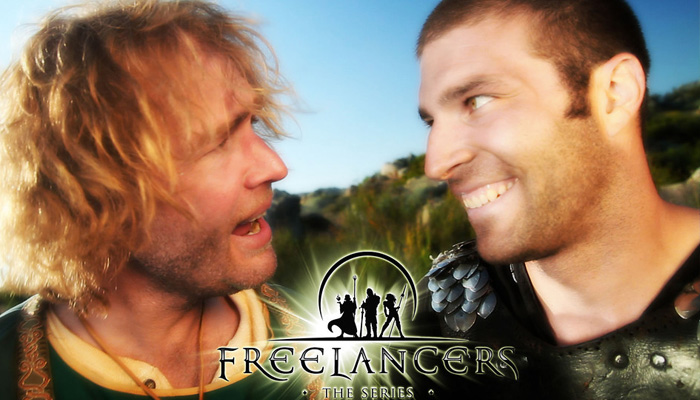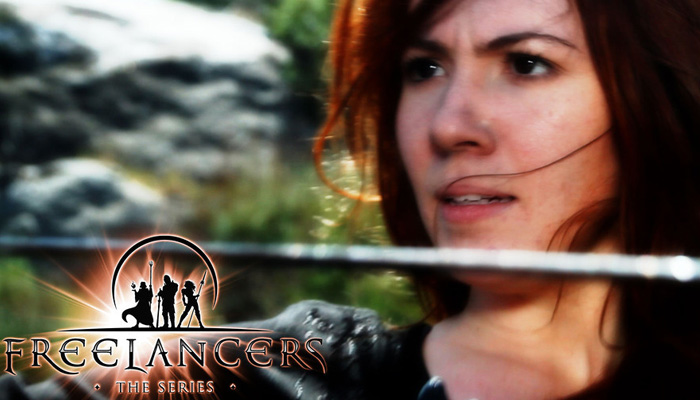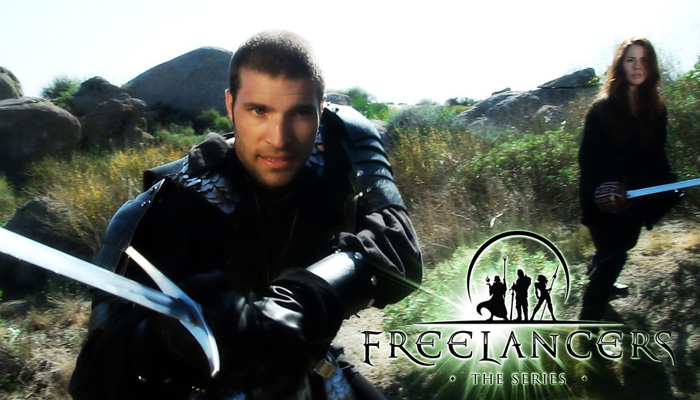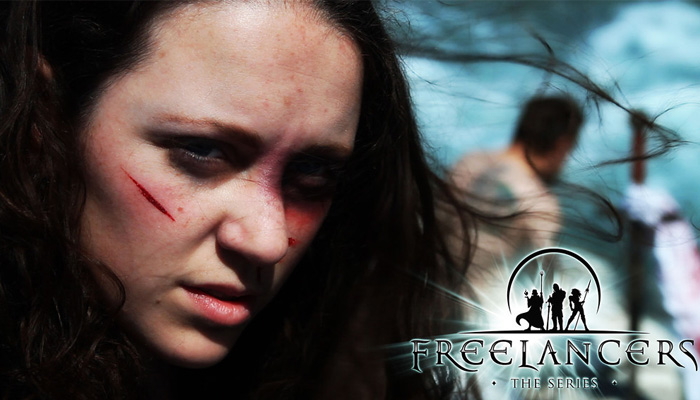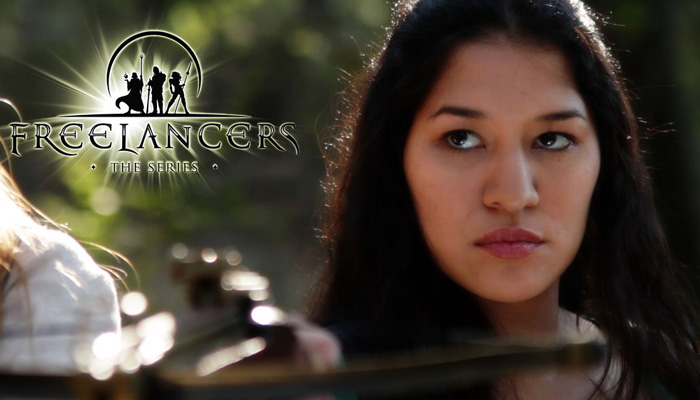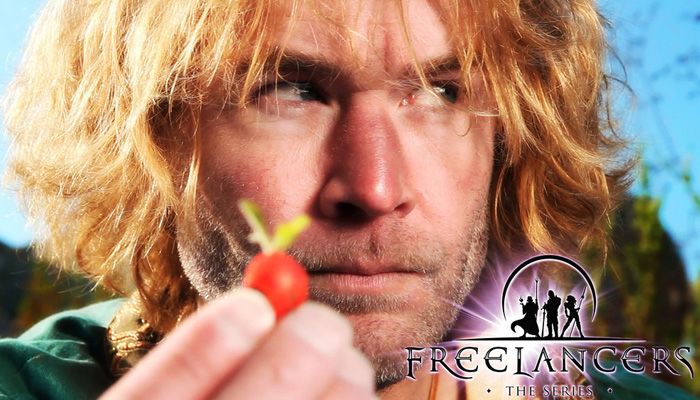Freelancers should be looked at almost as a how-to on getting fantasy on a budget done right. With sumptuous visuals, great acting and some lethal looking props, it’s a genuine accomplishment at any scale. Today we speak to director, Ignatius Fischer to try and figure out exactly how the hell he pulled it all off.
Just for those who haven’t read our review – how would you describe Freelancers?
Freelancers The Series is a fantasy action adventure set in a timeless realm full of magic and monsters, wizards and warriors, dungeons and … dragons. Inspired by classic literature, modern games and a wide array of cinematic influences, the show features fast-paced, action-packed storytelling, subtle visual effects, romance, adventure and comedy. There are no prophecies and no one is saving the world – there are just flawed characters with extraordinary abilities trying to make a living. Even the powerful can be comedic while the lowest-level rogue can be as evil as the day is long.
Freelancers takes a very different approach to fantasy than most other web series, taking place in slightly more serious world, and shying away from the usual “geek humour” that shows like The Guild, Journey Quest and Standard Action champion. What was your inspiration for the series?
My foremost intention with Freelancers was to not spoof the genre. While I love the shows you’ve mentioned (truly, Felicia Day and The Guild directly inspired Freelancers), I have always wanted to watch an alternative to both the comedy fantasy out there and the heavy Lord of the Rings/Game of Thrones type of stories, which are uber-serious (and which I love as well, lol). The first fantasy novels I read were Margaret Weis and Tracy Hickman’s Dragonlance Trilogy, quickly followed by the first three Drizzt books (Icewind Dale Trilogy) and I have loved the fantasy genre ever since. (Currently I’m a huge Joe Abercrombie fan!)
I began playing D&D in high school and continued through my stint as a Cavalry Scout in the US Army and of course I’ve lost a year or three to games like World of Warcraft, Skyrim, etc. The other side of my inspiration comes from my love of Indiana Jones, lol – Raiders of the Lost Ark is one of my favorite films and I thoroughly enjoy the tone of that story. I’ve always wanted to see the fantasy genre filled with “common man” type of characters from a gaming perspective, where the “common man” can throw fireballs or carve up a troll with a magic blade. Most fantasy genre stories seem to be told from the points of view of kings and knights and evil wizards, I always wanted to see characters like the ones I played or the people with whom I played.
Unlike a lot of people getting into making web series, you established a brand first with Witness Pictures – how did that help with producing Freelancers?
The Witness Pictures brand (http://www.witnesspictures.com) came into being when my producing partner, Brian Dillon, and I started doing a lot of freelance production work. I had created the company to produce short films under and we eventually produced two microbudget features which led to what was probably our biggest break – Marcus Chait hired us for Author Solutions (now a part of Penguin Publishing), along with several other filmmaking teams, to create “cinematic book trailers”. That allowed us to grow our brand with multiple short creative projects, but most importantly what came out of producing almost 40 book trailers in two years was the experience of having to create whole worlds within a very limited time frame and with a VERY limited budget.
We taught ourselves how to streamline production, casting and set design and we learned how much you can create with very little resources. It was hard work but it was like film school on crack, lol. We have been able to put together a very tight-knit cast and crew that we like working with and who, apparently, likes working with us (it’s pretty special when your cast and crew will follow you out into the wilderness and put up with extreme conditions just to film some crazy idea you wrote down on a piece of paper).
Freelancers was Kickstarted after the first few episodes had been made, with the intent of wrapping up the series. Was Kickstarter a more useful tool for harnessing your existing fanbase, or for expanding it?
For us, Kickstarter was very useful in expanding our audience. When I first presented the notion of producing a web series to my collaborators, a lot of folks asked if I was going to run a Kickstarter campaign to find the initial budget, but I was very resistant to that idea. My main reason for producing the show out-of-pocket was I felt that to try to run a Kickstarter campaign without an audience would be pointless – if you don’t have an audience, who are you going to market the campaign to? When we finally needed to run a Kickstarter campaign to finish this first season, I had a ton of content to show in addition to the fact that we had been cultivating a small audience up to that point. During our Kickstarter run, our audience grew because of that exposure – we had just as many contributors come from folks surfing the Kickstarter web series category as from direct contact (email and Facebook campaigns).
I attribute a lot of that particular success to the Freelancers’ fantastic logo, which was designed by my incredibly talented friend Bimal Gorajia. Since all you see on a Kickstarter project listing page is a thumbnail and a one-liner, I think the logo did a lot to attract attention – like the show, it’s slick, well designed, original and imparts, hopefully, a feeling of quality.
The series is sponsored by Rogueflix, the “Action Lifestyle Network” – were you expecting a pledge at that level from anybody? It must have been a pleasant surprise?
RogueFlix (http://www.rogueflix.com) acquired the show for a one-year digital distribution license several months before we ran our Kickstarter campaign – they acquired us during the 2012 American Film Market based on our initial trailer. They are great guys and I know that signing with them helped us to find some financing before we even went the Kickstarter route. It was a great surprise initially to have someone want to distribute us before we’d even finished the show! They have supported us in our crazy endeavor as well, being very understanding about our constantly late delivery process, lol, they understand the predicaments independent/microbudget filmmakers run into all the time.
Freelancers is a very professionally put together series, what previous experience do you have in filmmaking?
I started out in studio filmmaking fabricating miniatures for movies like Titanic, Dante’s Peak and Species II. My first job was to build the front end of the Earth warships in The Fifth Element. After computers sort of killed the practical effects industry, I went on to write screenplays for several independent filmmakers. The first feature length screenplay I wrote that was fully produced and achieved international distribution was The Men Who Fell. After that project I started shooting and cutting my own short films and then made my first feature for $15K (Lisl and the Lorlok (http://www.lislandthelorlok.com), which stars my daughter and Ivan Borntrager from Freelancers.
It won a couple of awards (Best Picture and Best Actor) at local film festivals. I directed photography on a feature for Brian Dillon that we shot over 7 days in three locations (Thursday’s Lovers). I essentially have worked in every department in film production, from production design to camera to admin and in both studio and independent productions and that experience has definitely helped prepare me for wearing the multiple hats I do on our indy productions.
Everything from the sound and editing to wardrobe and props worked fantastically together. How did you find such a talented crew?
Finding not just a talented crew but also a group of individuals you can get along with is probably the single most important thing you can do as a filmmaker. It has taken years for me to get to this point where I have such a great rapport with several brilliant artists – it’s actually very hard to do this, which I think is why you’ll see the same list of names on every project I do, from grips to actors. Filmmaking is such a difficult thing to do that when you work with people you don’t get along with, regardless of their skill or talent level, it can make it absolutely unbearable. So when you find a person who says, “Yes, I’ll follow you into the wilderness, I’ll slag through the heat, the bugs and snakes, the lack of cell phone service, the lack of proper latrines, just to play make-believe with you,” you do everything you can to hang onto that person, both as a friend and as a collaborator. If the show is great, it’s because of them, not because of me!
What was the casting process like – were characters written for specific actors, or were there auditions?
To date I have never held an audition – that’s not say I won’t in the future, but Freelancers is built from a core group of actors I will not work without and I wrote most of the parts for each of them individually. The exceptions to this are the characters of Krisitan (Holiday Kinard) and Verlinden (Jeff Doba), both of whom I cast via Actors Access. When I cast for people online, I need to see them in videos and usually their work will stand for itself. Everyone else in the show to date is someone I have worked with in the past in some capacity, even if it was on someone else’s set, lol.
The series also boasts some fantastic locations – how do you even begin finding the “right” patch of forest for a shoot like this?
Locations on a show like this (meaning a show without permits and on a tiny budget) become one of the biggest issues you have to figure out. Our locations had to meet some minimum criteria, such as 1) how far is the location from the nearest bathroom, 2) how much trouble can we get into if we’re stopped by park rangers or law enforcement, 3) how good does it look on-camera and 4) how close is it to a road or other noise-generating area. Brian Dillon and I scouted for approximately two weeks before we found the main forest location and the first episode’s rocky location.
We drove around in an ever-expanding radius looking for places that had tree cover, could provide at least 180 degrees of background that was devoid of modern things like power lines and telephone poles and that were somewhat easily accessible, having a place to park up to 10 cars at at time, etc. Often we’d find places that fulfilled one or two criteria but not all of them. And even though we were able to park relatively close to our locations, we still had to haul gear and water across rough terrain for 10 – 20 minute hikes.
Episode 4 isn’t out yet at the time of this writing, but that entire episode is very different from the rest of the season insofar as it is takes place entirely amongst structures and sets, featuring both interiors and exteriors. The single biggest issue we had with all of our outdoor locations (as any filmmaker will tell you) was sound – in Southern California I don’t think there is a single square inch of land that isn’t underneath the airspace of either a commercial or local airport of some type. Planes overhead easily cost us a third of our shooting time, just trying to get workable audio. The first day (episode 1) was so bad we almost didn’t make our day because of it. And on a show like this, ADR is damn near out of the question because of lack of budget.
What has the production process been like? How does a typical day of filming break down?
Because this show was done on an out-of-pocket basis, it was piecemealed together. This is NOT how you should produce a web series (or anything else for that matter, lol). The production process was strung out over time due to costs, so I would purchase or put together a costume with Dana Winchell (wardrobe designer) for a new character whenever we had the money to get it done, and then we’d schedule a shoot whenever we had the money to get that done. Usually we’d get costume pieces in the mail a few days before we actually shot them. A typical day of filming starts thusly: I give the shooting schedule to Brian Dillon who then sends out call sheets to cast and crew, making sure everyone is onboard and available (the process of scheduling usually took a couple of weeks to line everyone up). The day before shooting, I would catalog all the costumes and props we needed (invariably I would forget one key item, every time) and I would purchase the craft services and lunch for the shoot and store all of that in coolers and containers.
The morning of a shoot, usually around 430am, I would pack my beat-up old Toyota minivan (whose driver and passenger doors do not open) to the gills with camera equipment, food and wardrobe. Brian Dillon would have secured a campsite the night before near our shooting location, at which we would all meet and utilize the restroom facilities. Cast would suit up in their wardrobe and then we’d head out to the parking location near our shooting location, then we’d haul gear through the woods to wherever we were going to shoot. Our typical crew was Brian Dillon running sound, Jared Moore gripping and assisting camera and myself operating and directing. Usually we’d have one additional person onset, either Dana Winchell for wardrobe help, running slate and holding a bounce board or some other poor soul we duped into helping us for the day. Often there were more actors on-set than crew. We’d shoot for five hours, drive back to the campsite for lunch, bathroom breaks, and then back out to shoot until the sun went down. After wrap, I would go home, start footage transcoding, drink beer and pass out, lol.
Was it difficult getting the cast and crew out to location every day?
For all the outdoor locations, it was a fairly tedious process to schedule the day (which, again, any filmmaker will tell you that scheduling is probably the most hated part of production) especially when I would write ridiculous scenes featuring 9 or 10 characters. The other issue with most of our “forest” locations was that there was little to no cell phone service, so once you were up in the mountains, you couldn’t communicate with anyone. It’s actually a miracle we were able to create what we did, lol! Once my friend Mayra Rodriguez (Quill) sat in a camp site office for five hours wondering if we’d played a joke on her because we couldn’t reach one another and she didn’t know where we were shooting! When we shot the episode 4 scenes, which take place in taverns, fairy tale mansions and alchemist shops, we were so happy to be able to drive right up to a location and plug in lights, it was luxurious by comparison!
Any production highlights so far?
For me, every single moment we were actually rolling camera was a highlight – the amount of work and luck it took to get this stuff in front of camera really makes it seem like you are somehow doing the impossible. I would love to mention Beverly Stephenson, who let us shoot at her amazing house for four days. People see these scenes and do not understand how we created them for no money and as far as episode 4 goes, it was due entirely to Beverly’s stunning generosity. One highlight near and dear to my heart is this: Beverly is a self-professed lover of fairy tales and fantasy (to the point that she custom-built herself something evocative of a Disney-designed Fantasyland home).
We were shooting a scene where Caitlin (in the middle of a cat burglary) is coming down Beverly’s wide spiral staircase, sword drawn, creeping downstairs looking for danger. Camera is on the ground floor on a dolly and Caitlin starts her move on the second floor landing. We’re shooting this at midnight and Beverly and her husband are watching movies with their granddaughter in their upstairs bedroom. At one point, Beverly walked out of her room to see Caitlin waiting for action and she says, “It’s a dream come true to see a girl with a sword standing on my stairs.” I will never forget that!
Anything you’re going to do differently for season 2?
Everything, lol! The main things we’ll do differently for season 2 is we’ll put our budget and locations together upfront and then schedule a 3-4 week shoot to knock out the whole season like a feature film – which is how you’re supposed to do it. We will also have the incredible stunt choreographer Chase Rivera on-set as well as additional vfx artists for Derek Nickell to supervise. I will finally get off the camera and collaborate with a real cinematographer so that I can devote 100% of my attention to directing when the camera is rolling.
Compared to other genres, Fantasy is difficult to do right. What were some of the larger obstacles you had to overcome to get the series out as it is?
I wrote a blog post early on (the Freelancers Tumblr blof is kind of a mashup of a director’s diary and promotion for the show, http://www.freelancerstheseries.tumblr.com) commenting on how we broke basically every logical tenant of microbudget production:
Don’t do a period piece.
Don’t require visual effects.
Don’t do stunts.
Don’t write more than four speaking parts.
Fail, fail, fail and fail. LOL.
One major issue we had is that we had originally planned to do 13 episodes for season one, but it became clear about halfway into our first year that this was not going to happen, so rather than sacrifice what quality we were generating, I decided to break the first season up into two seasons, so while these first five episodes are mostly character and plot setup, Season 2 will really be able to show some character development. We realize this makes season one a potentially confusing and maybe frustrating experience insofar as the audience will have to wait to see how all of these characters will ultimately interact and how the story arcs will pan out, but rest assured that we have a complete story plotted out to its completion.
The series has a very authentic and believable look thanks to its realistic weapons and amazing costumes – how do you go about developing such a defined look?
We’ve received a lot of compliments on the look and production value of the show and we really appreciate that. I was adamant that we were not making a spoof or a facsimile of the genre, I want to create a world that is as real as it can be for what we have to work with. Part of that is making sure that what you see in the frame is as sharply designed as possible. And most of that simply has to do with aesthetics. Again, this season is essentially run-and-gun filmmaking, but as far as costumes go, Dana Winchell and I used Pinterest to curate images from across the web on a character-by-character basis; we would find shoes and shirts and skirts and hats and all sorts of things to inspire our designs.
Most of the time we had to just rely on what my stunt and mercenary character actors had in their closets (as they are all Renaissance Faire aficionados) and put things together that had some base level of design. But once in a while we were able to design, fabricate or rent amazing ensembles; some specific examples are Saorise’s dress in episode 4, which was provided by wardrobe designer and actress Debradawn Shockey, Kristian’s wardrobe which I am proud to say I designed and purchased piece by piece myself, lol (her corset coat was custom made from http://www.damselinthisdress.com and her blouse was custom made by Kim Cabassa Cresson https://www.artfire.com/ext/shop/bio/thewitchesspindle), and Verlinden’s outfit, which was put together by Dana Winchell, who also fabricated his incredible frock coat from scratch!
Witness Pictures are also working on Dust and Blood – a feature length production starring Freelancers’ Caitlin Geier. Is this something you’re filming at the same time as Freelancers, or do you try and keep the productions separate?
Dust And Blood is a western Caitlin and I have been slowly preparing for a couple of years. The screenplay is co-written by myself and Emerson Bixby based on a treatment I wrote almost ten years ago. We will produce Dust And Blood and Freelancers Seasons 2 and 3 independently of each other and sequentially rather than simultaneously. It’s difficult for me to keep two stories in mind at once (from a quality and production standpoint) and I prefer, whenever possible, to be able to focus on one large-scale creative project at a time.
Complete the sentence: “If you like x, x and x – you’ll like Freelancers�
If you like Game Of Thrones, Dungeons and Dragons or The Princess Bride, you’ll probably dig Freelancers!
Lastly, what is Freelancers filmed on?
Freelancers Season One was shot on a Canon 7D and a Canon Rebel with a variety of cheap lenses, the main lens being a Tamron 28 – 105mm f2.8 constant aperture Adaptall.
Well that concludes our (goliath) interview. Thank you so much for taking the time out to answer all of our questions. Readers, I hope that was as enlightening for you as it was for us. As always, all relevant links below!
